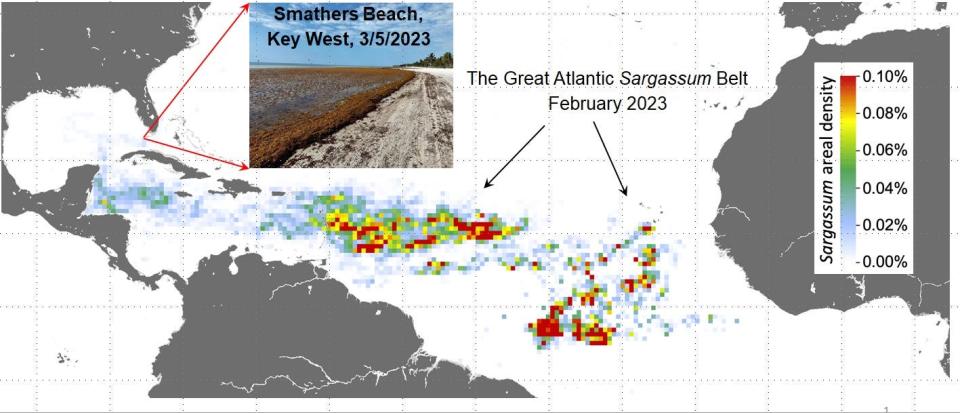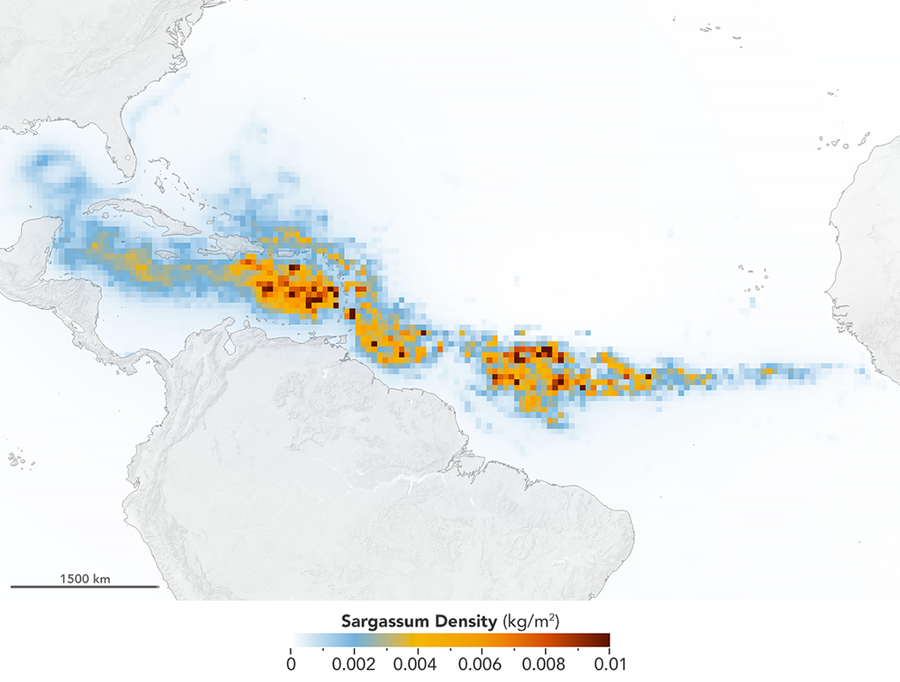A 5,000-mile-wide mass of seaweed is headed for Florida. Is Pensacola Beach at risk?
A monstrous 5,000-mile-wide mass of macroalgae called sargassum is making its way to Florida, but where it ultimately ends up is up still isn’t clear.
Sargassum is a genus of brown macroalgae or seaweed that is commonly found throughout the world, but abundantly so in a patch of the Atlantic Ocean called the Sargasso Sea. The massive drift of seaweed isn’t new. Christopher Columbus wrote about sargassum during his voyage to North America.
However, in 2011, researchers began to observe explosive growth in the belt, known as the great Sargassum belt, thought to be sparked by excess fertilizer, raw sewage and soil runoff.
Is climate change responsible? Big, stinky blob of algae takes aim at Florida beaches. What's causing it?
8.7 tons: Huge seaweed blob on way to Florida is 'like a Stephen King movie'
Will the sargassum mass impact Florida? Seaweed clump nearly double the width of U.S. floating at sea.
The floating mass, which stretches across the Atlantic Ocean from Africa to Florida, saw even more alarming growth this winter.
"This year could be the biggest year yet," even bigger than previous upticks, said Brian Lapointe, an algae specialist and research professor at Florida Atlantic University's Harbor Branch Oceanographic Institute.
It's already beginning to wash up in the Florida Keys and Barbados and elsewhere in the region, but researchers don't know where the bulk of it could wind up.
The monstrous seaweed bloom is just one more example of a growing global invasion of macro and microscopic algal blooms thriving on an increasing supply of nutrients such as nitrogen in freshwater and marine ecosystems.
What is sargassum?

Sargassum is a naturally-occurring type of macroalgae found in the ocean. Berry-like structures found throughout the plant’s web of appendages and branches called pneumatocysts are filled with oxygen that enables the plant to float along the surface of the water, allowing it to freely drift with the surrounding currents.
These rafts of sargassum can stretch for miles and serve as a valuable habitat for a range of marine creatures, offering food, shelter and breeding grounds.
It also serves as a primary nursery area for a variety of commercially important fish like mahi mahi, jacks and amberjacks, according to the National Oceanic and Atmospheric Administration.

What’s causing the latest bloom?
Algal blooms have been linked to human activities, according to a recent Nature study about coastal phytoplankton. Things like lawn fertilizers, wastewater and agricultural runoff increasingly send pollutants into rivers, lakes and oceans.
"These nutrients are the common thread that ties all the algal blooms together," whether it's sargassum, red tide, or blue green algae, Lapointe said.
He has linked the surge in sargassum to flow from the Mississippi River, extreme flooding in the Amazon basin, as well as to the mouth of the Congo where upwelling and vertical mixing of the ocean can bring up nutrients that feed the blooms. He said deforestation and burning also may contribute.
Are Pensacola beaches at risk for sargassum?
Sargassum has beached itself along Pensacola shores for a very long time. Its impact depends on how much drifts ashore and the surrounding environment.
If you're a beachgoer, you probably won't have much to worry about, though you might not want to get too close. Once the seaweed washes up on the beach, it begins to rot in the sun, releasing a pretty fowl smell and producing hydrogen sulfide gas, which can cause breathing difficulties in people.
"If you have beautiful tourist beaches, you don't don't want to have seaweed decaying on your beaches," said Dr. Jane Caffrey, a professor in the UWF's Center for Environmental Diagnostics and Bioremediation.
According to Carrey, Pensacola Beach saw big rafting last year, but it went mostly unnoticed among the public.
However, large portions could be costly when it comes to removal and dangerous to local marine creatures.

Jeffrey Wade, director of UWF's Center for Environmental Diagnostics and Bioremediation, says the rotting seaweed isn't easy to clean up and the county has had to bring out big machinery to clean the beach in the past.
In addition to the unsightly piles of sargassum along the coast, some species produce toxins that affect the food chain or deplete the oxygen in the water when they start to decay, causing fish kills and the die off of other marine species.
Is climate change affecting algae blooms?
Blooms have been at least indirectly linked to climate change in several ways, but especially to the warming temperatures that bring more extreme rainfall that washes silt and pollutants into waterways.
The authors of the coastal phytoplankton study, Lapointe and other researchers have found the following:
A correlation in some regions between changes in sea surface temperatures and ocean circulation.
Warmer temperatures coincided with blooms in high-latitude regions such as Alaska and the Baltic Sea.
Climate change can affect ocean circulation and the movement of nutrients that feed phytoplankton blooms.
Global climate events, such as El Nino, also show connections to bloom frequency and movement.
Algal bloom-favorable seasons in temperate seas have increased with warmer temperatures.
Where is the sargassum heading?
"We can't really say which particular beach at which particular time," Barnes said. The university publishes a regular update on the status of the sargassum bloom.
"We can get an idea of when it will be fairly close," he said. "In general, everything flows west. It will come across the Central Atlantic and into the Caribbean, and into the Gulf of Mexico through the straits of Florida."
Winds, currents and even small storms can influence where the sargassum moves.
Puerto Rico and the U.S. Virgin Islands could get hit pretty hard, Barnes said. But the floating mats also wind up on beaches in Jamaica and all around the coast of Florida.
USA Today climate, environment reporter Dinah Voyles Pulver contributed to this story.
This article originally appeared on Pensacola News Journal: Sargassum seaweed blob headed to Florida. Is Pensacola at risk?

